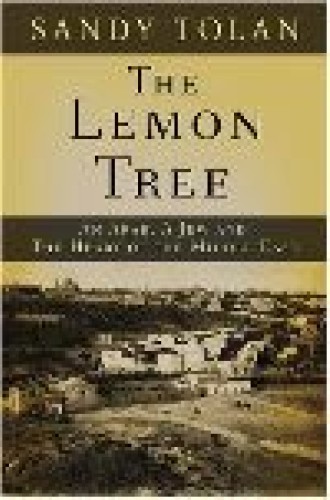The Lemon Tree: An Arab, a Jew, and the Heart of the Middle East
Palestinians, Israelis and others active in peace and human rights work sigh when political dilettantes come to the Holy Land convinced that they will start the dialogue group that will bring peace—as though no one had thought of promoting dialogue before. I thus approached Sandy Tolan’s The Lemon Tree with some cynicism. The book chronicles the dialogue between Bashir Khairi, a Palestinian intellectual, and Dalia Eshkenazi Landau, whose family moved into the home from which Khairi’s family was driven by Jewish forces. If Tolan had been writing according to formula, Dalia and Bashir would have overcome their pasts, become great friends and worked together to end violence. Instead, The Lemon Tree is an unflinching assessment of how the events of 1947-1948 and afterward make such a relationship impossible.
Writers who consider the plight of Palestinians in light of the horrors that drove European Jews to Palestine often end up minimizing the suffering of Palestinians during the 1940s. Tolan provides a balance I have seen in no other source. After detailing the rescue of Bulgarian Jews, among them Dalia’s parents, from deportation to Treblinka, Tolan writes about the expulsion of the Khairi family—along with thousands of other Palestinians—from the town of al-Ramla in the blistering heat of July 1948. A cousin of Bashir, Firdaws Taji, told Tolan about the march from al-Ramla to Salbit. Taji remembers that a white crust formed around everyone’s mouth, that people drank urine and that mothers dipped their dresses into a well of stagnant water so their children could suck on the fabric. Tolan traces the Khairis’ plunge from relative affluence to the sad, desperate lives of refugees.
After the 1967 war, Bashir Khairi visited the home his father had built and saw the lemon tree his father had planted. This visit set in motion the relationship that is the book’s central topic. If Tolan were writing according to formula, Bashir would have been grateful to Dalia for letting him into her house, and afterward he would have proclaimed to fellow Palestinians that Israelis are not so bad. Instead, Tolan documents the resentment Bashir felt when Dalia treated him like a guest in his own home and his parents’ pain as they pumped him for information about their house. When Dalia made a reciprocal visit to the Khairi family in Ramallah, Bashir told her that the one thing she could do to make things right with his family would be to return to Europe—along with all the other Jews who had emigrated to Palestine after 1917.
But Dalia kept up the relationship with the Khairis, even though they believed that Palestinians had a right to resist the Israeli occupation by any means necessary—a belief that resulted in Bashir’s spending 15 years of his life as a political prisoner. In doing so, Dalia revealed that she was made of sterner stuff than the typical Peace Now Israeli whom Palestinians regard with a jaundiced eye. When her parents died, she consulted Bashir about what his family wanted her to do with the house. Dalia had envisioned a center for Arab-Jewish dialogue, but Tolan shows that the center was only Dalia’s dream. Bashir told her that he wanted the house to be a day care center where Arab children—descendants of the families who managed to stay in al-Ramla—could find a happiness denied him as a child. Today the house serves both functions.
Tolan never glosses over the fact that Dalia has choices that Bashir does not. She can choose to visit him in the West Bank; he cannot choose to visit her in Israel. She can choose to consult him about the house; he does not have a legal right to be consulted. However, the fact that a committed Zionist and a committed Palestinian resistance leader have kept up a relationship over the recent years of spiraling violence is significant.
Sometimes the complexities of anti-Semitism, colonialism and religion that contribute to the big picture of the Israeli-Palestinian conflict turn Israelis and Palestinians into mythological figures. Tolan outlines this picture, and people wishing to understand the origins of the conflict will find that background useful. But by focusing on Dalia and Bashir as individuals, he has done something remarkable. The small details of their lives—Dalia’s ability as a child to identify Holocaust survivors by the look in their eyes, the petrified lemon that the Khairis kept in a glass cabinet as a relic—somehow convey a more profound and encompassing truth than most histories of the conflict I have read.




